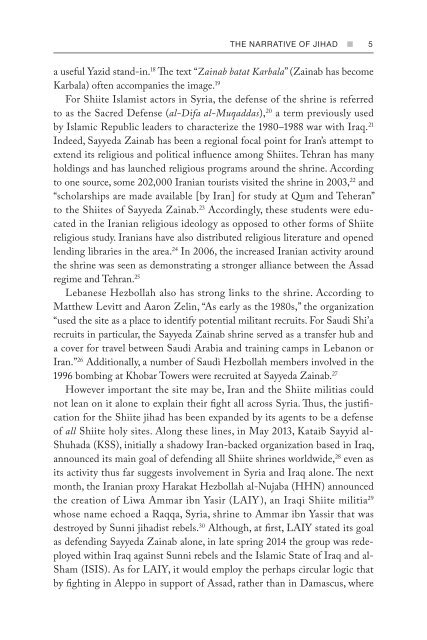Create successful ePaper yourself
Turn your PDF publications into a flip-book with our unique Google optimized e-Paper software.
<strong>THE</strong> NARRATIVE OF <strong>JIHAD</strong> n 5<br />
a useful Yazid stand-in. 18 The text “Zainab batat Karbala” (Zainab has become<br />
Karbala) often accompanies the image. 19<br />
For Shiite Islamist actors in Syria, the defense of the shrine is referred<br />
to as the Sacred Defense (al-Difa al-Muqaddas), 20 a term previously used<br />
by Islamic Republic leaders to characterize the 1980–1988 war with Iraq. 21<br />
Indeed, Sayyeda Zainab has been a regional focal point for Iran’s attempt to<br />
extend its religious and political influence among Shiites. Tehran has many<br />
holdings and has launched religious programs around the shrine. According<br />
to one source, some 202,000 Iranian tourists visited the shrine in 2003, 22 and<br />
“scholarships are made available [by Iran] for study at Qum and Teheran”<br />
to the Shiites of Sayyeda Zainab. 23 Accordingly, these students were educated<br />
in the Iranian religious ideology as opposed to other forms of Shiite<br />
religious study. Iranians have also distributed religious literature and opened<br />
lending libraries in the area. 24 In 2006, the increased Iranian activity around<br />
the shrine was seen as demonstrating a stronger alliance between the Assad<br />
regime and Tehran. 25<br />
Lebanese Hezbollah also has strong links to the shrine. According to<br />
Matthew Levitt and Aaron Zelin, “As early as the 1980s,” the organization<br />
“used the site as a place to identify potential militant recruits. For Saudi Shi’a<br />
recruits in particular, the Sayyeda Zainab shrine served as a transfer hub and<br />
a cover for travel between Saudi Arabia and training camps in Lebanon or<br />
Iran.” 26 Additionally, a number of Saudi Hezbollah members involved in the<br />
1996 bombing at Khobar Towers were recruited at Sayyeda Zainab. 27<br />
However important the site may be, Iran and the Shiite militias could<br />
not lean on it alone to explain their fight all across Syria. Thus, the justification<br />
for the Shiite jihad has been expanded by its agents to be a defense<br />
of all Shiite holy sites. Along these lines, in May 2013, Kataib Sayyid al-<br />
Shuhada (KSS), initially a shadowy Iran-backed organization based in Iraq,<br />
announced its main goal of defending all Shiite shrines worldwide, 28 even as<br />
its activity thus far suggests involvement in Syria and Iraq alone. The next<br />
month, the Iranian proxy Harakat Hezbollah al-Nujaba (HHN) announced<br />
the creation of Liwa Ammar ibn Yasir (LAIY), an Iraqi Shiite militia 29<br />
whose name echoed a Raqqa, Syria, shrine to Ammar ibn Yassir that was<br />
destroyed by Sunni jihadist rebels. 30 Although, at first, LAIY stated its goal<br />
as defending Sayyeda Zainab alone, in late spring 2014 the group was redeployed<br />
within Iraq against Sunni rebels and the Islamic State of Iraq and al-<br />
Sham (ISIS). As for LAIY, it would employ the perhaps circular logic that<br />
by fighting in Aleppo in support of Assad, rather than in Damascus, where


